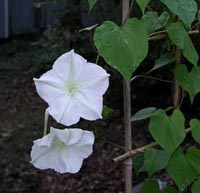Resource Library
Plant of the Week: Moonflower
The University of Arkansas System Division of Agriculture does not promote, support or recommend plants featured in "Plant of the Week." Please consult your local Extension office for plants suitable for your region.
Plant of the Week
Moonflower
Latin: Ipomoea alba

Moonflower is a fast-growing, old-fashioned annual vine that seems to have been forgotten by gardeners as they explore the new offerings of the garden industry.
Who has the patience to actually grow a plant from seed and wait several months for it to bloom? We want it now, thank you.
Moonflower (Ipomoea alba) is a close relative of morning glory and, like it, produces a long, slender, twining vine capable of growing a dozen or more feet high in the course of a year. The vine is capable of climbing a string, a chain link fence or sprawling over nearby shrubs.
It’s now established as an escaped plant throughout most of the world’s tropical areas, but it probably originated in Central America. In the deep South it forms a tuberous root and will survive as a perennial, but in most of Arkansas it’s annual.
Plants grow quickly from seed, forming large heart-shaped leaves up to 6 inches across. The moonflower blooms best in late summer and early fall, provided it doesn’t get too dry. The delicate, ephemeral white blooms are solitary and 5 to 6 inches across with a long, slender tube. Each blossom is marked with a narrow, five-pointed star in a slightly different shade of white.
Blooms open in late afternoon and are closed by the morning. Though I’ve not seen it, I suspect the large luna moth with its 6-inch long coiled proboscis provides pollination services.
Moonflower vines coil clockwise, regardless of where or how they are grown. Charles
Darwin published his Movement and Habits of Climbing Plants in 1875 where he detailed
his experiments and observation. He observed that some species twined in one
direction while some went the other way and was unable to reverse the direction by
applying different stimuli. The oft heard statement that twining is reversed in the
Southern Hemisphere is not correct. They’re programmed to rotate in only one direction.
Moonflower seeds were studied in the 1970s to see if they contained lysergic acid, a natural alkaloid called ergine which is remarkably similar in chemical structure to the hallucinogenic drug LSD. Unlike the common morning glory, moonflower was found to have no hallucinogenic properties.
Growing moonflowers from seed is easy. Because they have a hard seed coat, nicking the seed coat with a knife tip or rubbing seeds with a piece of sandpaper will improve germination. This is probably not necessary with seeds obtained from the seed companies but may help with pass-along seeds.
Seeds can be planted it in any reasonably good garden soil that receives at least six hours of bright light during the day, but don’t plant until the soil temperature has warmed above 65 degrees Fahrenheit. If you’re in a hurry, seeds can be planted indoors in a container and then transplanted to the garden when the soil warms.
By: Gerald Klingaman, retired
Extension Horticulturist - Ornamentals
Extension News - September 16, 2005
The University of Arkansas System Division of Agriculture does not maintain lists of retail outlets where these plants can be purchased. Please check your local nursery or other retail outlets to ask about the availability of these plants for your growing area.